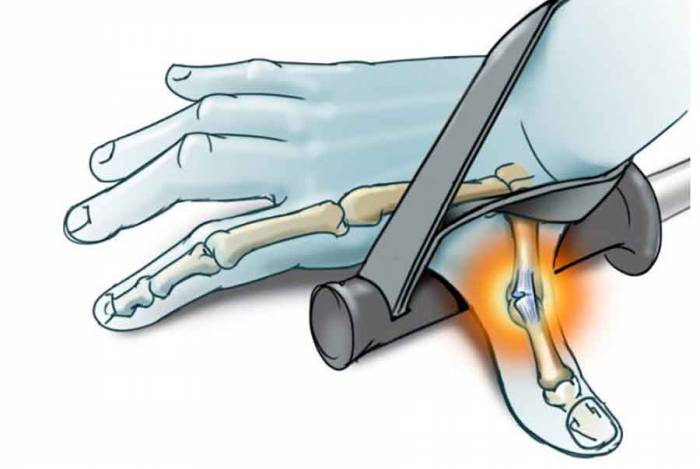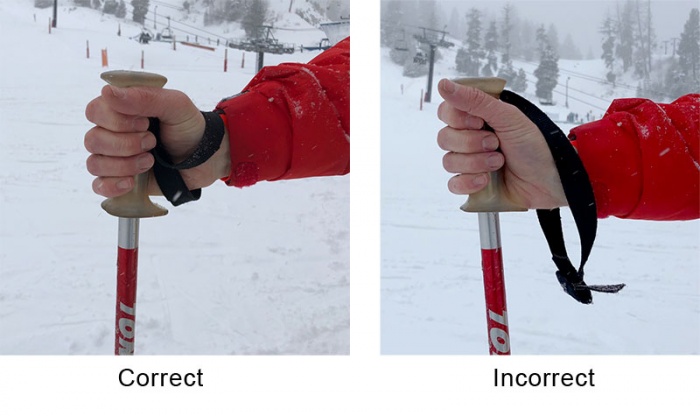A hyperextended thumb isn’t an emergency, but it can be debilitating and requires medical evaluation.
It’s a blue-bird day, the slopes are fast, maybe even a little icy. You catch an edge, throwing your body out of balance. To save yourself, you instinctively reach out to try and stop the fall. You land on the grips of your poles, causing an immediate throbbing pain in your thumb.
What Is Skier’s Thumb?
Skier’s thumb occurs when you try to stop a fall with arms outstretched and land on the pole’s grip. The force of the fall focuses on the grip and can cause the ulnar collateral ligament (UCL) of the thumb to hyperextend, strain, or tear.
While somewhat common among skiers, it ranks pretty low on the list of what causes UCL injuries as a whole. Skiers account for just 2.4 percent of these injuries.
Fun (somewhat gruesome) fact: Skier’s thumb is also referred to as “gamekeeper’s thumb,” named after chicken farmers who repeatedly broke chickens’ necks over their thumbs, injuring their UCL over time.
How To Identify
After you take a fall, determine if a UCL injury occurred.
- Is there pain where the thumb meets the hand?
- Is the thumb swollen?
- Do you feel a tenderness where thumb and web meet the index finger?
- Is there bruising around the thumb?
- Is there referred pain in the wrist?
- Do you have a weak grasp or find it hard to tie your shoes?
- Is there pain when you pinch thumb and index finger (“OK” symbol)?
If you experience any of these symptoms, you’re going to want to see a doctor for further evaluation.
What To Do If Encountered
If you are at a resort, get yourself to the doctor. Skier’s thumb isn’t considered an emergency. But because the injury affects grip, you won’t be able to safely drive a car. Instead, have someone drive you to the doctor’s office.
If you are in the backcountry, fashion a splint to immobilize the thumb joint. Or, “buddy tape” the thumb to your index finger to stabilize the joint and prevent the finger from catching on anything.
How To Avoid
Adjusting grip is the best bet to avoid UCL injury while skiing.
Reach your hands from underneath the leash, then grasp the grip on top of the leash. This way, you can release the pole in a fall and let it drop away from your hands.
Gripping the pole with the leash over your hand and around the wrist traps the pole in your grip. This increases the potential for an injury when you fall.
Others follow general skiing tips: Watch your speed, stay in control, and don’t fight a fall.
Ski within your limits. If you are new to skiing, take a lesson to learn the basics of balance and control. Instructors can teach you ways to minimize the chance of a potential injury-causing fall.
Be aware of the conditions. Weather changes in the mountains affect the way your skis respond to snow. Be aware of the changes in conditions and modify your skiing appropriately.
Listen to your body. Feeling “off,” hungry, or tired? A slower response time can increase your potential for an accident.
Fall correctly. Trying to catch yourself with outstretched hands is the No. 1 cause of UCL injury. If you feel out of control and are heading into a fall, loosen the body, draw in the arms and legs, and go with the flow. This can help protect your joints from injury.
Don’t use ski leashes. Skiing leash-less allows you to ditch the poles quickly, decreasing the chance of falling on the pole and incurring an injury. Instead, use poles with finger grips and learn to let go of the poles in a fall.
Treatment
A doctor will perform a physical exam to test the joint for mobility and may order an X-ray to check for broken bones.
Proper evaluation will indicate whether you have a sprain, rupture, or bone avulsion.
Depending on the severity of the injury, you may be prescribed time off, a splint, or – at worst – it might require surgery.
The thumb plays a critical role in daily tasks. Skier’s thumb can be a disrupter, but early intervention has a high rate of success. You should be back on your game within three to four months.
But unchecked, skier’s thumb can lead to a chronic instability of the thumb joint, hampering your thumb’s ability to grasp over the long haul. Make sure you see a physician as soon as possible – maximum within 10 days – to ensure proper healing.








